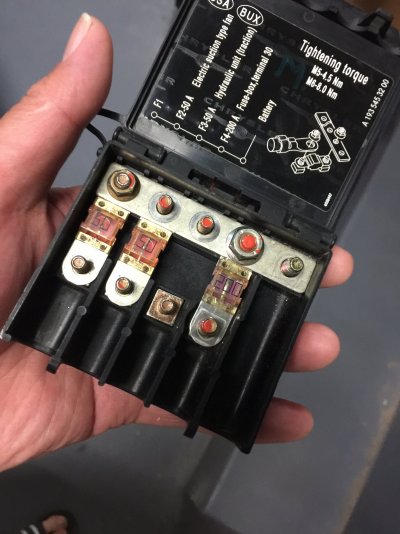I thought i got it, but..
Batteries are not charging with that many amps anyhow and the rest of the FACTORY electrical draw is connected to alt side of fuse. ok
The batteries would have to be dead and shorted beyond bringing back to put 200A of load on the alternator. You'd be aware of problems LONG before that point!
Batteries are parallel on starter, also bypassing fuse. ok
Yup- the starter wire isn't fused. The starter wire goes to the solenoid and is only a closed circuit for very short times. The solenoid would be more of the fuse than anything. Some cars have a fusible link in the starter wire, though.
BUT if there was a draw of 200A direct from either battery, wouldn't the factory fuse/wiring still be a bottleneck for the alternator?
The 200A draw isn't being supported by the alternator. It's being supported by the battery that can support an 800+ amp load. And you have two batteries so you're good for 1,600 amps. The alternator is just recharging the batteries. It having a higher amp output means it'll support the batteries discharging as they feed that 200A load faster and for a longer time period.
conceivably a big enough alternator could supply the juice, thus not running the batteries down?
Yes. This is the idea and is why audio system competitors run multiple alts on their multiple batteries.
I know I shouldn't up-rate the fuse with stock cables, but how about on your upgraded cables? That's what led me to think about adding ONE additional alt charge wire to the aux battery, paralleled in the same way the batteries already are on the starter and block.
Fuses protect the circuits. If the wiring feeding an electric motor, like a cooling fan, can only withstand 20A before it burns up, it'd have something like a 30A fuse. If that fan motor shorts out or the insulation on the wiring rubs through and shorts on the body- whatever would make it pull more than 20A, the fuse would pop so the circuit immediately goes dead instead of letting it heat up and burn. Larger cables don't "push" more amperage to the circuits. The point of upsizing the wiring, as with a Big 3, is because all the electrical circuits on the car are somewhat starved for power because the wiring is too small. Actually, providing the proper voltage to the loads makes them draw fewer amps. All my fuses are the stock specs.
I see what you're saying about the extra charge wire to that extra battery. To directly answer that- yes, if that battery has its own ground, then that charge wire would help. It's still all stock wiring that's barely adequate in a stock setup. You're far from stock electrical loads with a 2,000 watt inverter.
Why do all upgraded alternator manufacturers suggest a larger fuse? Where do the extra amps we should have available go?
Because if you're maxing out the alternator, too small a fuse can blow. Typically, larger alternators are to support the batteries powering heavy equipment, large amplifiers, etc. You shouldn't be within a dangerous range with your proposed plans and with having two batteries. You might be close, but if the stock fuse rating reliably supports your loads, leave it. It's safest and that's the point of fuses. If you have a DC amp clamp, then you can put some factual numbers to all of this.
Regarding power wires, planning to use this little box, 1/0 cable might just fit.. (.5" opening)
View attachment 399689
Well, that's cool. There's that fused distribution block we were talking about earlier. lol

